HEEY-YOO! And welcome to the whimsical world of solo travel in Japan!
Are you SUPER stoked?
And, BTW, the only correct answer to that question is an emphatic yes since Japan is ALL things wonderful!
I mean:
You’ve got hedgehog cafes, ramen, sushi, kimonos, REAL LIVE MARIO KART, arcade games, beyond quirky fashion, ancient Buddhist temples, ethereal mountain ranges, capsule hotels, and SO MUCH MORE. Just be sure to learn exactly how to take solo travel photos before you go.
This way you have ample photographic evidence of the wicked awesome time you had.
But to REALLY seal the deal:
You’ll be beyond delighted to know that yes, Japan really does have it’s very own, Wizarding World of Harry Potter!
So:
All my fellow Potterheads out there, feel free to rejoice, and give praise to all things Japanese.
However:
Let’s slowly move away from my slightly random obsession with all things Harry Potter, and towards something slightly more helpful.
Like this SUPER awesome guide to all things Japan solo travel, which you can use to help you plan the perfect Japan 2 week itinerary and introduce you to some of the best places to visit in Japan.
Because in this post, not only will you find a ton of tips on how to stay safe in Japan, but you’ll also learn how to use public transportation in Japan, discover the best time to visit Japan, find out where to go in Japan, and even get a TOTALLY FREE, 7 day Japan itinerary!
Because yes, I too love all things free (Minus diseases, those are never lovely).
So, let’s make like a piece of sushi and ROLL our way into this post about all things Japan solo travel.
Sorry, but for me, wickedly lame puns never go out of style.
This post may contain affiliate links. Please see my disclosure for more information. As an Amazon Associate, I earn a small commission from qualifying purchases.
Solo Travel Japan 101: How to Stay Safe During Your Solo Trip to Japan

Learn how to stay safe as you solo travel Japan!
Thinking of embarking on some Japan solo travel and planning a 2 week Japan itinerary in Autumn?
Excellent! Because Japan really is one of the safest countries in the world for solo travel (#winning).
BUT it’s not 100% perfect….
Sure, Japan is known for its low crime rates, its next level organization (at the bureaucratic level since nothing is late here…EVER) and polite, friendly people,
But:
That doesn’t mean that you shouldn’t remain vigilant as you solo travel Japan.
So:
Use all of that awesome common sense that I know you have and take the same precautions that you would in any country.
Therefore:
Continue to do super obvious things like avoid walking down dark alleyways alone late at night, keep an eye on your personal belongings, don’t get too intoxicated, etc.
You know, all the usual stuff.
Because like basically every other country on the planet, Japan definitely isn’t immune to organized crime.
Yeah, I had no idea either. But apparently:
The ‘Yakuza’ is well known in Japan and is involved in murder, corruption, petty crime, and overall, high levels of not-so-nice mayhem.
And while it is unlikely that they’ll ever target a group of selfie stick-wielding tourists, it’s still a good idea to be aware of their presence, especially as you do some Japan solo travel in big cities, like Tokyo.
1) Be Prepared…You Won’t Be Able to Read Anything
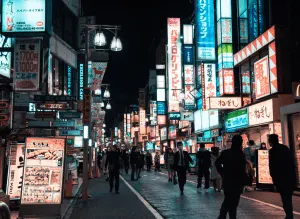
As you solo travel Japan, you’ll quickly see that there is a distinct lack of English signage.
‘It’s cool I’ll just follow the signs’… said no one in Japan.
Ever.
Well, unless of course, you can actually read Japanese. OBVS.
In general though:
English is NOT universally used throughout Japan, a fact that can make getting around more than a little bit tricky.
Therefore:
Have your Google maps app handy and be prepared to get lost, more than once, during your solo trip to Japan.
Also:
Always have the address of your hotel handy (in both English and Japanese), just in case you get lost and need to share this information with a super helpful local.
This should help with that awkward language ‘what the hell are they saying’ barrier.
BUT:
Always take the directions you are given with a pinch of salt.
See:
Traditional, Japanese culture dictates that it’s better to give wrong directions than admit you are unable to help.
Therefore:
To avoid this mildly annoying possibility, try and ask for directions at a nearby hotel, where it’s highly likely that staff members speak English fluently.
And remember:
In Japan, hotel curfews are actually a THING.
That’s why:
Smaller, family-run accommodations may lockup between 10:00 pm and midnight.
So:
Definitely research those policies BEFORE enjoying a wild night out on the town (Excuse me while I trade in my granny panties for a pair of ultra-rad glow sticks and a Monster energy drink. Because yes, staying up past 10:00 pm really isn’t my “thing”).
Also:
When traveling solo at night, always have your route back “home” planned out BEFORE you down some Sake and sing your heart out at a Japanese karaoke joint.
Trust me:
You really don’t want to be doing any serious travel planning when you’re inebriated AF in a foreign country.
And if you do decide to drink:
Never leave your drink unattended since it could easily be spiked while you’re not looking; a trend that is, sadly, becoming all too common in the Tokyo and Kyoto bar scene.
2) Cash is King
Why?
Well, you might expect a tech hub like Japan to be card crazy, Am I right?
Surprising though, that is actually NOT the case.
In fact:
It’s actually quite the opposite.
So:
Do yourself a solid favor and grab some cash before you head out for the day, at least if you wanna avoid being penniless and having to frantically search for an ATM that accepts foreign cards.
Thankfully though:
Most hotels, 7-Elevens, and restaurants all accept cards.
But:
A lot of smaller places won’t.
Therefore:
Be prepared and ALWAYS have a bit of cash handy.
3) You WILL Experience Culture Shock
Because if you’re not, then you better be.
See, things in Japan are done a whole lot differently then they are in the Western world.
From toilets (Take my word on this one, because you will see what I mean) to local taboos like answering a phone call while riding public transportation (Yeah, don’t do this), there are a lot of things about Japan solo travel that you’ll need to get used to.
I mean:
Don’t freak yourself out about these taboos since Japanese people are really considerate and will take the fact that you’re a visitor into account.
But:
It’s still a good idea to brush up on your Japanese customs/etiquette BEFORE your visit, just so that you don’t cause unnecessary offense.
And if you can:
Always try and avoid doing anything that will draw too much attention to yourself since this is a big no-no in Japan.
4) Unwanted Male Attention
Oh, hell to the no!
Don’t panic though because it’s really not that bad.
Because thankfully:
Catcalling is not a thing here. Thank f*cking God.
That being said:
And Ladies out there should try and avoid using public transportation during peak hours since instances of sexual harassment and groping are quite common on crowded trains.
However:
To resolve this issue, some cities have started using ladies-only carriages during rush hour, which can be found by following signage along various train platforms.
5) Avoid Common Scams
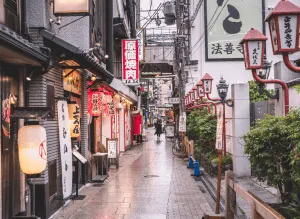
Japan is an incredibly safe country for solo travelers. However, there are some common scams that you’ll need to watch out for.
Like what?
Well, the main one to watch out for is the ‘Japanese nightclub scam’, especially when visiting well-known nightlife hotspots, like Tokyo’s Kabukicho.
See:
What happens is, a street tout will invite you into a club and shower you with attention and drinks…before swiftly presenting you with a not-so-awesome bill for a few thousand yen.
Yeah:
You will be expected to foot the bill for all those drinks (and for your “new found friend’s” precious time).
And if you refuse to pay?
Well, then things could get a bit dangerous and threats could be made.
So:
To avoid this scam, just walk away. Don’t even respond to anyone who invites you into a club.
Because even the most well-trained touts will take the hint and leave you alone.
But:
You also don’t have to be rude either. Just politely decline and move on.
And when in doubt:
Always remember the age-old adage that if it seems too good to be true, then it definitely is.
6) Watch the Weather
And I’m not talking about the rain.
See, unfortunately, Japan can be prone to freak weather conditions, like typhoons and earthquakes.
That’s why:
Before doing any solo Japan travel, it’s always a good idea to be aware of the seasons and know what to expect from the weather.
So, just a little FYI for you.
Typhoon season usually falls between May and October and peaks in either August or September.
Now:
Because earthquakes are quite common in Japan, it’ s a good idea to prepare yourself for an earthquake emergency.
And no, not by practicing hiding under tables (lol).
Just try and familiarize yourself with your hotel’s evacuation policy and always follow locals to designated safe areas if the worst should happen (Because yes, you guessed it. All public safety announcements will be in…Japanese.)
And the rain?
Well, it’s slightly less catastrophic, but sudden downpours are fairly common.
So:
Grab a cheap umbrella from the nearest konbini to keep yourself dry and avoid wandering around like a drowned street rat (Anyone else reminded of Aladdin right now? No? Just me? Right, swiftly moving on).
SOLO TRAVEL JAPAN: EVERYTHING YOU NEED TO KNOW ABOUT PUBLIC TRANSPORTATION!
Japanese trains are known for being some of the most efficient in the world. Yup, just one of many things to look forward to when planning your Japan itinerary.
However:
They can also resemble an unsolvable puzzle if you’re from out of town.
So:
Here are some general transportation tips to help you make the most out of your time in Japan.
1) Getting to the Center of Tokyo from the Airport
Whatever you do:
Do NOT take a taxi from the airport to your hotel.
Not only are they very UN-cheap:
But many taxi drivers actually can’t speak or read English, making communication more than a little difficult (Hello? Google Translate?).
That’s why:
Whenever possible, try and use the city’s monorail system, which connects directly to the subway.
This way:
You can quickly, easily, and somewhat cheaply get anywhere in the city that you need to go (You can also take the Keikyu Line directly to central Tokyo).
But, what if I wanna catch an Uber?
Well, Japan has technically had Uber since May 2018.
But:
I still wouldn’t use it as your “go-to” mode of public transportation since it’s not really widely used by locals.
However:
Things may be changing!
Because In 2020:
Tokyo will be hosting the summer Olympics.
And to ensure that spectators can easily move throughout the city, both Uber and Didi (A Chinese rideshare app) will be providing Tokyo with extra transportation services.
As a result:
Uber may become a viable transportation option when traveling to and from the airport.
However:
I wouldn’t bother using it for inter-city travel since the Tokyo metro is WAY cheaper.
But, until Uber becomes more popular:
You can always just download the ‘Japan Taxi app” before you go to Japan.
I mean:
It has over 60,000 taxis that cover all 47 prefectures of Japan.
Therefore:
You should definitely be able to find a decently priced taxi, no matter where you are in the country!
Plus:
Standard taxis in Japan really aren’t THAT bad, especially when traveling within cities since using a taxi over short distances is pretty affordable.
And added bonus?
Not only are they EVERYWHERE, but most of them also accept credit cards as a form of payment.
Which is great since I for one am all about minimizing my cash withdrawals and the foreign transaction fees associated with them.
***When traveling in Tokyo, be sure to download the ‘Takkun Tokyo Taxi’ app since most Tokyo-based cabs are on here. However, when using this app, you will be charged a small pickup fee.***
2) Platform Trickery
Just to amp up your level of Japan solo travel confusion:
Transportation services with similar-sounding names tend to be grouped together on the same platform.
As a result:
Many platforms will have several different categories of trains (e.g. local and rapid trains) arriving within a minute or two of each other.
Which can be insanely confusing since the names of all these trains SOUND EXACTLY THE SAME!!
That’s why:
You should definitely do your research BEFORE you arrive and know the difference between various train services.
Because while informational displays DO indicate the category of the next arriving train, they aren’t always in English!
Making them slightly impossible to read if you don’t speak Japanese.
Therefore:
If you can, try and identify different services using their Japanese names to avoid getting on the wrong train and ending up in some beyond random part of town.
3) The Great JR Rail-Pass Debate
Well, it’s not actually that great, but still.
Because a question that I often get is, “Should I get a JR rail-pass?”
And the not so straightforward answer is that, well, it depends.
See:
JR passes are great for Japan solo travel since they allow you to be flexible with your itinerary.
So:
If you’re not sure where you’re headed or when, then the JR pass is your new best friend, especially if you wanna take a ride on a bullet train.
But:
If you purchase a JR rail-pass, what do you actually get?
- Unlimited use of all JR trains from Kagoshima in the south to Hokkaido in the north.
- This includes the Shinkansen (bullet train) but not the Nozomi or Mizuho bullet trains. And while these trains are technically faster than the Shinkansen, I doubt you’ll actually notice the difference.
- You can also use local JR commuter trains, JR buses, and JR ferries.
- The JR rail pass is also valid on all five of Tokyo’s main railway lines!
However:
The JR Pass is costly, so definitely make sure that you plan on doing at least a few long-distance train journeys, on premium trains, if you want to get the most out of the money that you spent on this pass.
But wait, how much does a JR Pass actually cost? Well, as of winter 2019:
A 7- Day pass costs $273.83
A 14- Day pass costs $436.37
A 21-Day pass costs $558.29
And this is all PER PERSON. So yeah, NOT cheap.
For many travelers though:
Riding on a long-distance bullet train (Shinkansen) is kind of like a right of passage.
So, if this sounds like you:
Then plan on taking at least two different trains per week.
Otherwise:
It would actually be cheaper for you to buy individual tickets and not a 7-day JR pass.
Some other JR-Pass tips:
- If you are just staying in Tokyo, then this isn’t the pass for you since local trains in Tokyo are pretty cheap (around $1 per journey).
- You can pay more for a ‘Green pass’ (a first-class pass), but it’s not really necessary since the standard trains in Japan are immaculate.
- Don’t be late!! In fact, be EARLY since Japan takes time management VERY seriously.
Now:
If you do decide to get a JR rail-pass, then save yourself some time and buy it in advance (GET YOUR JR PASS RIGHT HERE, RIGHT NOW!)
In fact:
You actually HAVE to get your Japan Rail Pass BEFORE you arrive in Japan (AGAIN, to be SUPER CLEAR. You CANNOT get a Japan Rail Pass within Japan!!)
So:
Definitely order it online, prior to the start of your trip, and then just have it delivered to an address outside of Japan.
And once you finally arrive in the country:
You can easily get it validated at any local ticket office.
But wait!
Tell me more about this ticket validation process.
Well:
Before you board a train, you will first need to trade in the voucher that you received in the mail for your actual JR Pass.
And once you have your JR Pass:
Do try and reserve your JR pass train tickets in advance, especially on busy days/peak seasons/weekends since no one wants to get to the station, only to find out that their train is completely sold out!
To do this:
Just write down all the trains that you want to take (or bring a Hyperdia print out with you) and then bring this info to the JR Office at the station.
To make life easy:
Just make your train reservations when you exchange your online voucher for an actual JR pass.
But:
If you don’t have it all figured out, not to worry.
Because the official JR pass website ONLY recommends reservations when traveling between April 27th- May 6th, August 11th- 20th, and December 28th- January 6th.
And the rest of the time?
Well, you can easily board a train without a reserved seat since the designated, JR Pass seats will be clearly marked on the train.
And if you’re still not sure whether the JR rail-pass is right for you, then just run your route through hyperdia.com and compare the cost of one-way tickets with the cost of a JR Pass.
And just go with whichever option is cheaper.
Now:
Bonus tip #1!
Most Japanese trains have limited storage space. Therefore, travel light and DO NOT pack everything except the kitchen sink.
Bonus tip #2!
Looking for that Insta-perfect shot of Mount Fuji?
Yeah, I feel you.
If so, then when traveling from Tokyo to Kyoto, ask for a seat on the right-hand side of the train.
Trust me:
Sit here and you are guaranteed to have the best seats for maximum camera snapping action.
And yes, feel free to thank me later.
Other Ways to Get Around as you Solo Travel JAPAN
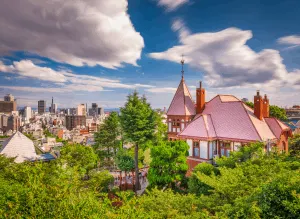
Japan is an amazing country. But sometimes using its transportation system can be more than just a little tricky.
1. TOKYO METRO (THE BEST WAY TO GET AROUND TOKYO)
The Tokyo subway system consists of two interconnected networks, the Tokyo Metro and Toei Subway.
Trains and subways in Tokyo also run between 5:00 am and 1:00 am daily, are religiously on time, and arrive every 3 mins during peak hours (Peak hours are on weekdays between 8:00 am and 9:00 am and shortly after 5:00 pm. Morning rush hours also tend to be more concentrated and heavier than evening rush hours).
Oh, and girl, (and guys) don’t forget…
- Swipe your passcards both on the way in AND on the way out. The digital screen is awesome and will display the remaining balance on your card.
- Most train stations have multiple exits- so remember to take the right one!
- Consider the “Tokyo Subway Ticket“ which provides unlimited use of all subway lines. Pick it up at either Narita Airport or Haneda Airport for the ultimate freedom during your Japan solo travels.
- Queuing is an art form here and you will be expected to do so on the platform. Just be prepared because there will be a mad dash to nab a seat during rush hour.
- The most useful line in Tokyo is the JR Yamanote Line, which is commonly referred to as the “Tokyo Loop Line” or just the “Loop Line.” You can use your Japan Rail Pass on this line.
- Another great way to pay for trains and subways in Tokyo is with a prepaid Pasmo or Suica card since it is WAY cheaper than buying individual tickets.
2. BUSES
Thought trains were complicated?
Well, think again!
Because Japanese buses are a little bonkers!
I mean:
-
- You need to board the bus from the middle and not the front
- You will collect a plain, slip of paper as you board the bus. This piece of paper will have a number on it. And…TADA, this is your bus ticket
- The electronic board displaying ever-changing numbers at the front of the bus may confuse you! But, please use it before you hop off the bus since the cost of your bus fare will be displayed under your seat number, AKA the number that is printed on your ticket
- The driver will expect you to deposit both your bus fare and your ticket, into a designated collection box BEFORE you leave the bus.
However:
You could always just skip all this confusion and get a Pasmo card instead.
Remember though:
This card is only valid in the Tokyo/Yokohama region and is sort of like a Metro/Travelcard/Oystercard for Tokyo’s metro/buses.
Now, if you do purchase one:
Try and put at least $30 on the card since this will cover quite a few journies.
From here:
All you need to do is tap your card when you board a bus (or metro), and then again when you get off.
See! Super simple!
And while buses are great to use in small cities and in the countryside, I would avoid using them in major cities, like Tokyo, since there’s a lot of traffic and it will take you forever to get anywhere.
I would also avoid using buses over long distances.
EXCEPT IN KYOTO!
Yeah, don’t ask me why but it’s actually cheaper to use the bus than the train in Kyoto.
So:
Some of the different types of buses that you’ll find in Japan are:
- Route buses (which operate within cities and towns),
- Highway buses (which operate between large cities),
- Limousine bus (which operate between the airport and a major bus station)
And out of all of these different types of buses, you’ll probably end up using route buses the most.
But, are they really worth using?
Well, like with all forms of public transportation, they have their own set of pros and cons!
A major pro is cost.
Because you can definitely use buses as a low-cost alternative to the train.
For example:
You can catch a bus from Tokyo to Kyoto, for just 1,599 JYP ($15) which is WAY cheaper than the train.
Plus:
Buses are also insanely comfortable and come with wicked awesome, reclining seats (Some ever have full-on SALONS!!).
However, one GIANT con is time!
Because the above journey will take you over 7 hours by bus and just 2 hours and 15 minutes by train.
A lot of long-distance bus journeys also take place overnight, which is great for saving money, at least if you’re comfortable doing this alone.
So:
If you wanna save money, take the bus.
But:
If you wanna save time, take the train.
Because it really just depends on which one of those things is more important to you.
***PSST: Don’t discount sightseeing buses since The Chuo Bus from Sapporo to Shikotsu and the Toya Lakes is a great way to see some of Japan’s most amazing scenery.***
3) Plane Travel
Thinking of cutting down on your travel time by flying across Japan?
Well:
While it is doable, it’s definitely not the most cost-effective way of traveling through Japan.
That’s why:
When traveling between cities, I’d still recommend the train.
But:
For longer journeys, like the one between Fukuoka and Sapporo, I’d consider flying since it’s the fastest way to travel.
And if you do decide to fly:
Try using smaller, domestic airlines, like Skymark and Jetstar Japan, which usually have cheaper fares.
PS:
You can also check with the airline operator of your international flight (BEFORE you arrive in Japan) and see if they offer discounted domestic fares to passengers who fly on their international routes to Japan.
Yup, something that is definitely worth checking out.
4) Ferries
Now:
We all know that Japan is an archipelago.
And as such:
Ferries are a constant form of transportation between islands.
That’s why:
- Some smaller islands, like Naoshima can only be reached by ferry
- Ferries can be useful for traveling among Japan’s four major islands. But, information on ferry routes (including schedules and fares) is almost always in Japanese ONLY!
- If you ‘re interested in traveling by ferry, instead of train, then the ‘Japan Ferry Pass 21’ is the sea equivalent of the JR Rail pass. Covering 14 routes over 21 days, it’s about a third of the cost of the rail pass is just $192 per person.
But is it right for me?
Well, if your route/time schedule allows for ferry travel, then this can be a viable transportation option.
Just plan on making at least two trips to some of Japan’s other islands if you want the Japan Ferry Pass 21 to be cost-effective.
However:
I would ONLY recommend this option if you’re looking for a slower form of transportation.
Because if getting to your final destination QUICKLY is more important than the journey itself, then this isn’t the option for you.
***Another added benefit of traveling by ferry is that you can save money on overnight accommodations, something that is never cheap in Japan! Plus, ferry cabins are usually relatively comfortable, modern, and clean.***
WHEN IS THE BEST TIME OF YEAR TO SOLO TRAVEL JAPAN?
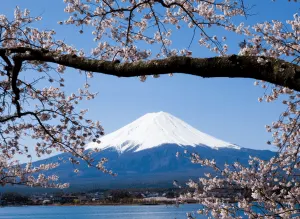
Any time between March and May (minus Cherry Blossom season) or between September and November is probably the best time to solo travel Japan.
TBH:
It’s never really a bad time to do a bit of Japan solo travel.
But:
You will definitely get a very different vibe from the country, depending on when you visit.
So:
If at all possible, try and plan your visit between March and May (Minus cherry blossom season, which varies depending on where you are in the country) or between September and November, when weather is mild, prices are at their lowest, and when crowds are not as crushingly huge.
Now:
If you do decide to visit during the spring, psych yourself up for it because this is THE most famous (and busiest) time to visit Japan.
Why?
Two words. Cherry blossoms. Obvs.
Therefore:
Travel to Japan during this time of year and expect to be bombarded by hordes of tourists and locals who are all out celebrating the beautiful blossoms during hanami (blossom viewing) picnics.
However:
If you’re not fazed by epic levels of heat and humidity, then summer is a great time to visit Japan.
That’s because:
There are a ton of festivities that take place during this time of year.
So:
From dazzling fireworks displays to al fresco munching on street food, summer is definitely a fun time to visit Japan.
What?
Can’t deal with the crushing crowds of spring but still want to experience some of Japan’s insane, natural beauty?
Then considering visiting during autumn, AKA the season of red and gold leaves.
Trust me:
Japan’s countryside will come alive with vibrant colors, making it the perfect time to get outside and do a bit of hiking.
But, wait!
What if you’re really a snow bunny at heart?
Then Japan totally has you covered!
Just head up to Hokkaido in the North and enjoy some beyond epic mountain ranges that will make any snow-loving traveler drool.
Because yes my friends.
Hokkaido really is known as the ‘Swiss Alps of Asia’ for a reason and is the perfect place for any solo traveler who is desperately searching for ALL the Christmas feels (which are sometimes lacking in other parts of Asia TBH).
WHAT TO SEE IN JAPAN: 10 AMAZING PLACES TO VISIT
1. Tokyo
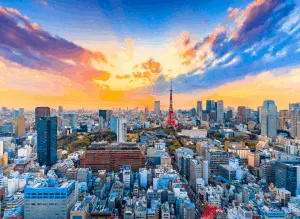
Tokyo Tower and the iconic skyline of Japan’s amazing, capital city.
You know those images that you have in your head of futuristic skyscrapers, neon lights, quirky fashionistas, video-game obsessed individuals, and over-the-top, one-of-kind activities?
And yes:
I’m 100% referring to owl, goat, and hedgehog cafes, as well as a real-life version of Mario Kart (FYI: You can also do this in Osaka AND Kyoto).
Well:
You’ll find all that and more in Tokyo since this modern AF city really does sit at the beating heart of contemporary Japan
That being said though:
There are also a ton of surprisingly traditional aspects of this city too, like sumo wrestling in Tokyo.
So yes:
Tokyo really is a place full of contradictions.
So:
When you visit Tokyo, be prepared to battle your way through crazy busy pedestrian crossings, to be overwhelmed by the sheer size of this place (Tokyo is truly MASSIVE), and fall in love with the city’s beyond divine 7-Eleven egg sandwiches (strange but true).
However:
If you swan dive headfirst into Tokyo’s fast-paced lifestyle, all this awesomeness can result in total sensory overload.
I mean:
From robot restaurants to amazing, panoramic city views atop the Tokyo Metropolitan Government Building in Shinjuku (free and deffo worth it!), this crazy busy city really does have it all.
So:
Try and take it easy while enjoying all the sights, sounds, and flavors that this vibrant metropolis has to offer.
However:
You are forbidden (do you hear me? LOL) from leaving this city without doing the following.
- Visit the Akihabara district for arcade games, ‘cute’ cafes, and delicious ramen.
- Walk across the famous Shibuya Crossing- if you dare!
- Wear some of the city’s fashions in Takeshita Street, Harajuku (Gwen Stefani eat your heart out)
- Try the soup dumplings and espresso tonic in Yokohama Chinatown (SO GOOD!!)
- Visit the CupNoodle Museum and make your own.
- Get your real-life Mario Kart on while driving through the crazy streets of Tokyo, in a go-cart, and dressed as your favorite Mario character. Slightly mental but hilarious. You also will need an international driver’s license for this so plan accordingly because they are strict about this.
- Explore the colorful Digital Arts Museum TeamLab Borderless.
Tokyo also gets extra brownie points from me since eating alone here is easy and uber-tasty too!
I mean:
Solo diners can happily, and not-so-awkwardly, eat at the bar of any Sushi, Tempura, and ramen joint in the city.
Yes, my friends, we call this living the dream.
And if you really want to live it up, you could even take an amazing Mt. Fuji tour from Tokyo.
Nine Hours Woman Kanda (Budget) – The Shinjuku and Ginza neighborhoods are perfect areas for solo travelers to stay. However, If you’re not careful, accommodations here can be pricey. And that’s where Nine Hours Woman Kanda comes in. With quirky, fun, and totally bonkers rooms, that start at $55 per night, this capsule hotel is the perfect place to stay in Tokyo. And while these establishments are traditionally for men only, many capsule hotels are now opening their doors to women (sorry but no men allowed), making this a fantastic, extra-safe, budget hotel option for any of my fellow, solo female travelers out there. I also love that this place has a cozy, minimalist vibe about it and is conveniently located near both Tokyo Station and the popular, Akihabara area.
Shibuya Granbell Hotel (Mid-range) – Want a stylish, boutique hotel that is also affordable? Then check out Shibuya Granbell Hotel near Shibuya station. Rooms here start at $110 per night and have this incredible, pop-art, minimalist design that is beyond cool. All rooms here also include free WIFI, flat-screen TVs, complimentary breakfast, and bike rentals, for an additional fee.
2. Kyoto
Want your Japan solo travel to be served to you with a side of geishas, temples, zen gardens, and cobblestone streets?
If so then Kyoto is for you!
Sure, Kyoto has its fair share of ugly high rise buildings, like any other major city.
But:
It won’t take long for an intrepid solo traveler like yourself to venture past those less than stellar buildings and discover vast mountain ranges, as well as various aspects of traditional Japanese culture.
Therefore:
While you’re here, you cannot miss out on:
- Temples. Kyoto is brimming over with temples!! So, choose the temples that you visit wisely. Also, try and visit first thing in the morning to avoid large crowds. My personal faves include Kinkaku-ji (Golden Temple), where you can actually get your fortune from a vending machine (SO Japan), and Kiyomizu-Dera Temple.
- Visit the iconic red torii gates of the Fushimi Inari Shrine.
- Take a morning stroll through the Arashiyama Bamboo Grove.
- Visit the home of a geisha in Gion and partake in a traditional tea ceremony/learn how to make matcha tea.
- Explore the beauty of Yasaka-jinja at night.
And if you’re hungry (because we all know that I always am):
Then be sure to try some of Kyoto’s famous ‘okonomiyaki’, a crispy, made-to-order pancake that is served to you with your choice of fillings.
Simple, yet oh so tasty!
And if you really want to get your foodie swerve on, then stop by Menya Gokkei (Northern district) for some authentic, beyond delicious, Japanese-style ramen.
However:
You can also hit up any Ichrian (AKA 24 hour booths where you can consume ramen totally by yourself) in town since this is basically any ramen loving, introverted traveler’s dream.
Slurp away my friend because you totally deserve it!
Now, for the best gyozas in town, visit the one and only Sukemasa. Not only is the food here delicious, but you can get a couple of gyozas, miso soup, rice, and pickles for less than $7.
Talk about an epic steal!
Tanaka-ya (budget) – With rooms that start at $52 per night, Tanaka-ya is a cute, budget-friendly, traditional, Japanese-style homestay that features tatami-mat flooring, paper sliding doors, and Japanese futon bedding. It is also conveniently located in Gion Miyagawa-Cho, making this the perfect home base for which to explore Kyoto’s iconic old town.
The Sekura Terrace (Mid-range) – Conveniently located near Kyoto Station, Sakura Terrace is an awesome place for any solo female travelers out there to stay. I mean, not only do they offer a comprehensive ‘ladies plan’ that includes meals, but rooms here are bright, start at just $84 per night, and feature floor-to-ceiling windows, flat-screen TVs, and free WIFI. There’s also an on-site, coin-operated laundry facility, just in case your clothes are starting to look a bit dingy.
3. Osaka
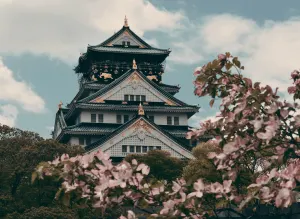
The old-world charm of Osaka Castle, one of the best places to solo travel Japan.
Another sprawling neon city:
Osaka is a mass of bright lights, amazing food, and affordable prices, at least when compared to its big brother. Tokyo.
So where to begin?
Well, food is ALWAYS a good place to start. Especially since I like eating just as much as I like breathing.
Plus:
Osaka is home to some SERIOUSLY amazing vegetarian cuisine.
No really!
It was so good that I basically wept tears of joy.
So:
If you’re looking to get your foodie swerve on, then devour some udon noodles at Azuma Udon, the city’s oldest udon restaurant.
Or:
If you’re total veg like me, then hit up Green Earth, a delicious vegan-friendly eatery with a set lunch menu, that features rice, a main dish, salad, a vegetable side dish, and soup, for just $8.
But:
If you actually wanna do something other than eat ALL of your feelings, then definitely:
- Ride the Ferris wheel on top of the Don Quixote store in central Osaka/. Trust me on this, it is the very definition of a one of a kind experience!
- Check out the bright lights of Namba. In particular, Dōtonbori is the most popular street in Osaka for viewing neon lights and animated signs, with the Glico Running Man being an Instagram fan fave (#justsayin’).
- Discover the quirkier side of the city in Shinsekai District, which is filled with arcade games and food halls. You can also enjoy some epic, panoramic city views from the top of Tsutenkaku Tower.
- Visit Osaka-jo castle. Nestled inside the city walls, this building is one of the oldest structures in the area and sits within a picturesque park (It’s also an extra stunning place to visit during cherry blossom season).
Toyoko Inn Osaka Umeda Higashi (budget) – If you’re on a budget, then business hotels can be a great option for you while you solo travel Japan. And one of the best in the area is Toyoko Inn Osaka Umeda Higashi. Now, while luxury it most certainly ain’t, it’s still clean, well equipped, and centrally located (It’s literally a 4-minute walk to the subway). Rooms here also start at just $30 per night and feature super snazzy things like WIFI, flat-screen TVs, mini-fridges, and tea/coffeemakers (Talk about the posh life! LOL). Complimentary breakfast is also available, as is access to a coin-operated laundry facility since, I mean, well, who doesn’t like clean clothes?
Hotel Monterey La Soeur Osaka (Mid-range) – Perched atop a high-rise building that overlooks the O River, this contemporary hotel has an American, art deco style to it. Yet, it somehow retains a distinctly Japanese vibe with warm rooms that start at $89 per night. This hotel is also just a 7-minute walk from the train station, and features an on-site French restaurant, tea room, bar, and gorgeous, next level divine, spa!
4. Nara
So, why should Nara be on every solo traveler’s bucket list?
Umm.
Because of the local deer that bow for food!
Okay.
In truth though, Nara definitely has way more to offer visitors than a chance to feed cute little deer.
See:
Nara is full of historic, Japanese treasures, making it the perfect place from which to indulge your inner culture vulture.
Because, believe it or not:
Nara was actually Japan’s first capital city and is home to a wealth of charming, ancient buildings that stand as a remnant of the city’s high profile past.
This also includes a variety of different UNESCO world heritage sites like the Hall of the Great Buddha (But, more on him later.).
And added bonus?
This historic city is easily accessible from both Kyoto and Osaka and makes the perfect day trip from either city since both places are just an hour away from Nara by train.
So:
While you’re in this ultra-fab metropolis, do not miss out on:
- The Daibutsu-den (Hall of the Great Buddha) at Todaiji. It’s arguably one of Nara’s most famous sights (besides the deer of course.) and features a 15-meter tall, golden Buddha that sits inside the world’s largest wooden building. Impressive much? I think so!
- Feeding some local deer in Nara deer park. Yeah, they are pretty friendly and will wait until the food is offered to them. So don’t worry about them stealing your lunch (The monkeys of Asia should take note!)!
- Eating some ‘Nakatanidou’, a famous Japanese rice cake. And while the ‘yomogi-mochi’ may sound gross, it’s flavored with mugwort plant and is actually super tasty.
- The Kofuku-ji Temple, which was established in 669 AD and has a great deal of cultural significance due to its links to the Fujiwara family.
Guest House Oku (budget) – For the ultimate trip down nostalgia lane, book a stay at the small, but cute, Guest House Oku. This charming little boutique hotel has spotless rooms, which start at $30 per night. And while bathrooms here are shared, the real appeal of this place lies with the friendliness of the hostess, Yoko, who goes out of her way to make guests feel truly at home and like they are having an authentic, Japanese experience. This hotel also serves amazing food, is incredibly safe, and is conveniently located near the center of the city.
Centurion Hotel Classic Nara Station (Mid-range) – Hallelujah! Finally, a hotel with a reasonably sized room that doesn’t inadvertently feel like a tomb. Because let’s be honest, spacious hotel rooms are a rarity in Japan. But, somehow, Centurion manages to deliver spacious, warmly decorated, comfortable rooms that are all still just a 5-minute walk from the nearest train station. Rooms here also start at $97 per night and include sofas (feel free to “oh” and “ah” at will), flat-screen TVs, tea makers, mini-fridges, WIFI, and air purifiers. And for an added dose of Japanese quirkiness, try using their coin-operated laundromat to freshen up your clothes before you leave the city.
PSST: Kyoto and Osaka are both a short distance from Nara and have WAY more options when is comes to accommodations. So, if you’re struggling to find what you’re looking for, then you can always book a stay in either city and just visit Nara as part of a day trip.
5. Takayama
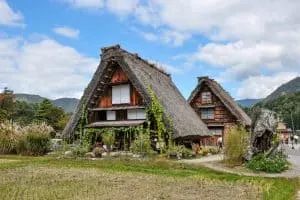
Some of the quaint, Japanese-style architecture that you’ll find in Takayama, Japan, at the base of the Japanese Alps.
Takayama might just win my award for the prettiest place EVER and is easily one of the best hidden gems in Japan.
Because no doubt:
This city if flippin’ gorgeous!
Why?
Well, it’s located on the edge of the Japanese Alps and is far less touristy than many other places in Japan.
And you know what I say to that?
Crowd free is the way to be! Because Takayama is basically THIS introverted traveler’s idea of a total dream!
Throw in some exquisite, traditional wooden houses, signature red bridges, and brightly colored shrines, and you may never wanna leave!
Other things that you MUST do while you’re here include:
- Go for a morning stroll around Sanmachi Street. It’s located at the center of Takayama Old Town and is where you’ll find many of the city’s lovely, traditional wooden buildings (perfect for the insta feed of awesome).
- Explore local, morning markets like Jinya-Mae (a small market that is located in front of the Takayama Jinya building) and Miyagawa (a market that sits alongside the Miyagawa River).
- Eat some ‘mitarashi-dango’ , or rice balls grilled in soy.
- Cycle through Shiroyama Park, a part of the Japanese countryside that sits just five minutes outside the city. Also, be sure to hike to the Takayama Castle Ruins and admire the incredible mountain top views from here.
- Visit Cafe DON for Coffee and Cake!
The Country Hotel (Budget) – At just $35 per night, this hotel is definitely no-frills. But, The Country Hotel still has everything you need for a comfortable stay (Think comfy beds, WIFI, air conditioning, etc.). They’ll even provide you with complimentary green tea and cozy slippers, both of which are clearly essential items for any wicked awesome hotel stay. This place also gets bonus points for its primo location since it sits right across the street from JR Takayama Train Station.
Takayama Olan Hotel (Mid-range) – This modern meets traditional, Japanese-style hotel has a fantastic, central location (Just three minutes from Takayama train station) and offers guests comfortably designed rooms that start at $123 per night (think luxe seating areas, posh dark wood furniture, free WIFI, tatami floors, futons, etc.). There’s also a buffet-style, onsite, restaurant where you can enjoy a delicious breakfast, for a small fee. However, the real highlight of any stay at the Takayama Olan Hotel is their stunning, open-air, roof-top, hot spring, which provides you awe-inspiring, panoramic views of the nearby, Hida Mountains.
6. Hakone
Okay.
So, you’ve probably seen all of those amazing photos of a beyond colorful ship that is gently gliding past Japan’s immortal, Mount Fuji.
And if not:
Well then, feel free to look it up on Insta right now. I mean, I can wait…not-so-patiently since a climb up Mt. Fuji Japan is the stuff that travel dreams are made of.
Anyway:
The mountainous town of Hakone actually overlooks this picture-perfect lake, which is locally known as Lake Ashi.
This town is also located inside the Fuji-Hakone-Izu National Park and is just a short (ish), 1.5-hour bullet train ride away from Tokyo.
Additionally:
This place is known, the world over, for its picturesque, hot springs resorts (AKA onsens in Japanese).
However:
In addition to its wealth of onsens, Hakone is also home to various world-class art museums, historic Shinto shrines (like the aptly named, Hakone Shrine), and expansive mountain ranges.
That’s why:
This tiny town makes for the perfect, weekend escape from the chaos of Tokyo.
And FYI:
You CANNOT leave this place without trying the black eggs!
And no:
They’re black because they’ve been infected with some rare strain of Bubonic Plague.
Instead:
This local delicacy, kuro tamago (black eggs), is created by cooking chicken eggs in the sulphuric hot springs of Owakudani – a volcanic crater that was formed over 3,000 years ago.
Apparently:
Legend says that eating just one black egg will extend your life by more than seven years.
So:
To procure these little fountains of youth for yourself, just stop by Kurotama Shop, in Owakudani, for some of the best black eggs around!
***While many people tend to visit Hakone as part of a day trip from Tokyo, I would advise against this. I mean, it’s doable but it just makes for a really LONG, really RUSHED day. So, if you have the time, definitely stay overnight in Hakone and enjoy your visit at a more relaxed pace.***
Hakone Tent (Budget) – If you’re looking for a unique hostel that is both reasonably priced and cozy, then this rustic guest house is for you. Once a Japanese ryokan in its former life, this building has long since been transformed into a comfortable, light, airy, and modern hostel that is just a stone’s throw away from Gora Station. Beds here sit inside six-person, single-sex dormitories, start at $30 per night and include tatami mats and futons. Private rooms with wood floors are also available here, as is WIFI, towels/sheets (for a fee), and access to an onsite cafe/bar. While staying at Hakone Tent, you’ll also get full access to their on-site, gender-segregated, hot spring facilities (Can I get a whoop, whoop? No? Okay, swiftly moving on).
Hakone Honbako (Mid-range) – Set along a quiet, tree-lined street is Honbako Honbako, the hotel of your literary loving dreams. See, ’honbako’ literally means ‘bookcase’ in Japanese. Which is a perfect name for this boutique hotel since It is brimming over with books, books, and, oh yeah, more books! I mean, the library here is outfitted with floor-to-ceiling bookcases that contain more than 12,000 different titles. Add in comfortable, modern rooms (which start at $173 per night) with hardwood floors, spacious beds, private outdoor baths (with geothermal water), minifridges, and tea/coffee makers, and you have the perfect place to stay in Hakone. Breakfast is also included with the price of your stay, as is access to an on-site cinema and the hotel’s gender-segregated hot springs.
7. Tsumago
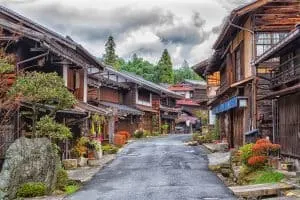
Some of the historic, Edo period houses that line the Nakasendo trail between Magome and Tsumago in Japan.
Why do I love Tsumago with my whole heart?
Umm:
Because it’s basically like this perfect little, tiny AF village (it’s so small that you can literally walk from one end of town to the other, in about fifteen minutes flat), that feels like a total blast from the past.
And I mean that in the BEST possible way.
Because while you’re here, you’ll find no cars during the day, no phone lines, and no power cables.
Instead:
You’ll discover a charming, Edo Era village that is overflowing with historic ambiance from the area’s wealth of traditional, dark-wood, lattice-front homes. All of which are particularly amazing at either dusk or dawn.
While you’re here though:
Also, be sure to visit the Tsumago Castle grounds for some amazing views of the city.
Sadly:
The castle itself was actually demolished hundreds of years ago, but the panoramas remain and are truly spectacular to behold.
And while the scenery here is truly next-level amazing:
You just cannot leave without visiting the Kotoku Temple, a traditional Buddhist temple built in 1500, and Wakihonjin, a charming history museum that showcases various artifacts from the area.
But enough about Tsumago’s ambiance already!
Because we need to talk about the REALLY important things in life…like FOOD (glorious food)!,
Now:
While I myself am not a meat eater, Tsumago is actually known for a traditional, local delicacy, that is supposedly a “must try” if you’re a real carnivore at heart.
So:
Head on over to Ryokan Fujioto and enjoy some local beef, which is served inside a magnolia leaf and cooked right in front of you, on a table-side, hibachi grill.
Shimosagaya (Budget) – Nestled in the mountains, small, private rooms at this charming Minshuku (AKA family-owned guest house) all start at $63 per night. And while it’s a simple building, accommodations here are comfortable, quiet, and basically all things zen. Guests here can also enjoy some made to order, home-style, Japanese cuisine, as well as access to private, on-site hot springs, making this the perfect retreat for any weary solo traveler.
Hotel Green Plaza Karuizawa (mid-range) – Unlike the budget option above, this hotel has a more contemporary feel about it. It also sits adjacent to a trendy shopping mall and is just a short walk away from Karuizawa Toy Kingdom (A perfect place to visit if you’re missing the distinctly Western vibes of home). Rooms here also have casual decor and include wood-framed beds, as well as a traditional, Japanese-style dining area with tatami mats and short-legged tables. Breakfast and dinner are also included with the price of your room (they start at $168 per night), as is access to the hotel’s free train shuttle, indoor/outdoor bathhouses, a chapel, a tea room, and various on-site restaurants.
8. Hiroshima
Ask nine out of ten people about Hiroshima, and they will immediately think of August 6, 1945; that horrific day when this Japanese city became the site of the world’s very first atomic bomb attack.
However:
In spite of this city’s devastatingly sad past, it has become a vibrant, cosmopolitan place that is brimming over with wonderfully beautiful messages of hope and peace.
That’s why:
As a solo traveler, you should definitely spend at least a few nights here, wandering through the area’s many idyllic, tree-lined boulevards and chatting with some of Hiroshima’s friendly, laid back locals.
But:
No trip to Hiroshima would be complete without a visit to Hiroshima Peace Memorial Park.
It’s a hauntingly beautiful, sprawling green space that is filled with various fountains, statues, memorials, and ruins, all of which stand in memoriam of the 146,000 people who tragically lost their lives on that fateful day.
And of particular note here is Genbaku Dome.
Once the Hiroshima Prefectural Industrial Promotional Hall (originally built in 1914), this abandoned building is now all that remains of the site where the first atomic bomb was dropped.
Today:
This edifice stands, exactly as it did after the bombing, as a powerful reminder of the devastating effects of nuclear weapons, and as a symbol of hope for a future that is free of this type of technology.
However:
Hiroshima is also home to several other, slightly less, incredibly heartbreaking attractions, like the Shukkei-en Japanese garden, and Hiroshima Castle, a beautiful, historic fortress that was built in 1590 and that is surrounded by a moat.
And for some of the best eats in the city:
Head down to Hiroshima Station and explore downtown Hiroshima, where you can try everything from okonomiyaki (PSST: Okonomi-mura is the best place in the COUNTRY to try this savory, Japanese-style pancake) to oysters (Yakigaki-no-hayashi is a great, local seafood restaurant where you enjoy some great udon sets as well as raw oysters) to Gelato (Okay, I know this isn’t a traditional Japanese food, but Polar Bear really is the best place to go for gloriously fresh and delicious gelato).
Hotel S-Plus Hiroshima Peace Park (Budget) – Sitting near the Hiroshima Peace Park, (the clue’s in the name guys!), this well-located hotel has functional, single rooms that come fully equipped with WIFI, a TV, a mini-fridge, and a tea/coffeemaker. Starting at just $31 per night stays here also include a complimentary, continental breakfast, as well as access to, YOU GUESSED IT, a coin-operated laundry facility.
Top Hiroshima Condominium 2 (Mid-Range) – This super snazzy hotel is less than three years old and is a mere 20-minute walk away from Hiroshima Peace Memorial Park (Which is good because the more you walk, the more calories you burn, and then the more you can eat! HOORAY!). Rooms here also start at $130 per night and include a private balcony (For prime city views here people), a queen-sized bed, a sofa, a TV, and a full kitchen, as well as an ensuite bathroom with free toiletries! Yup, nothing but the sweet, sweet, luxe life for me.
9. Kanazawa
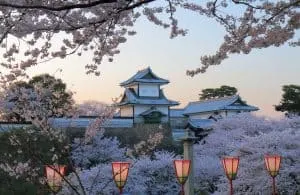
Beautiful Kanazawa Castle in Japan, amidst a sea of cherry blossoms.
Often nicknamed “little Kyoto” (and for all the right reasons):
Kanazawa is jam-packed full of fun things to do, activities that you can easily add to any, Japan solo travel itinerary.
But, don’t just take my word for it.
I mean, Kanazawa Castle and Kenroku-en Garden alone are considered to be some of the country’s top attractions!
However:
Kanazawa isn’t JUST about iconic castles and ethereal green spaces.
Walk through this city’s various Edo-era districts (like the Higashi Chaya district, which is where you’ll find many historic teahouses with geisha performances) and you’ll discover a multitude of fascinating museums (like the 21st Century Contemporary Art Museum), ancient Japanese buildings (like Seisenkaku Villa), charming local markets (check out Omicho Ichiba Market, which is just as good as the one in Tokyo, only A LOT less crowded), historic temples (like Ninjadera with all its secret doors and hidden traps), and quaint little handicraft shops.
And while we’re on the subject of markets:
Just around the corner from Omicho is Curio Espresso & Vintage Design, a great little coffee shop that sells fab espresso and delicious sandwiches.
That’s why:
A trip here is absolutely ESSENTIAL to your overall wellbeing and happiness while in Kanazawa.
Plus:
The owners here are SUPER friendly, and just an overall great source of local information about the city.
Sharin (Budget) – Complete with vintage bicycles out front, Sharin is just a 10-minute walk from Kanazawa Railway Station and offers guests easy access to the 21st Century Museum of Contemporary Art. And while this hotel does have several dormitories for you to stay in, there’s really no need. Because for a mere $23 per night, you can have your very own, private room, complete with an uber-spacious double bed (Can you say bargain, party of one?). See, dreams really do come true!
Libre Hosai Kanazawa (mid-range) – You want space? Then I’ll give you space! 42m² of space to be exact! Because believe it or not, Libre Hosai Stay Kanazawa lets you rent out an entire apartment for just $132 per night. So, think private shower, a spacious bathtub, and a snazzy AF little kitchenette where you can pretend like you “cook”. Now THAT’S what I call the LUXE life indeed. This place also conveniently located just 800 meters away from Omi-cho Market and Oyama Shrine.
10. Koyasan
Tucked away, to the south of Osaka, is Koyasan, a huge Buddhist temple settlement that lies (both figuratively and literally) at the very heart of Japanese Buddhism.
More commonly known as Mount Kōya:
This small, secluded, temple town was first developed around the Shingon Buddhism headquarters here.
And lest you think I’ve started speaking in tongues:
Shingon Buddhism is actually an important sect of the religion that was first brought to Japan in 805 AD, by Kobo Daish.
Today:
You’ll find a wealth of Buddhist temples within this tranquil, heavily forested, mountain town, as well as the site of Kobo Daishi’s mausoleum and the start/endpoint for the Shikoku 88 Temple Pilgrimage.
But:
To really get the most out of your visit, I’d HIGHLY recommend doing an overnight stay in a local, Japanese Temple.
Known in Japan as Shukubo, which literally translates to ‘sleeping with the monks’, this is a fantastic way for any solo traveler out there to really engage with Japanese culture and get an authentic, Japanese Buddhist experience.
So:
Live the dream and feel free to eat, pray, and love your way through the day, just like a local monk.
And if you get a sudden attack of the late-night munchies:
Then stroll on over to Kameya for some udon noodles and seaweed in vinegar.
Because:
I pinkie promise, both of these dishes are absolutely TO DIE FOR!
Guesthouse Fuki Juku (Budget) – Honestly, the location of Guesthouse Fuki Juki could not be any better since this place is literally SURROUNDED by local temples! There’s also a traditional Japanese garden on-site, as well as comfortable rooms that include both free Wifi and a delicious, complimentary, American-style breakfast. And while rooms here are a bit sparse (You’ll also have to use a shared bathroom, which I hate), it’s all good when you’re spending just $51 per night.
Yochi-in (Mid-range) – Yochi-in is the perfect place for visitors to engage in various, temple-related activities like meditation, morning prayers, sutra copying, and tracing of Buddhist deities. All Japanese-style rooms here also start at $143 per night and feature tatami (woven-straw) floors, futon bedding, a TV, fan, and heater. And while bathrooms are shared with other guests, the hotel’s central location more than makes up for this fact since this place is within easy walking distance of both Koyasan Reihokan Museum and Koyasan Choishimichi (two must-see attractions while you’re in the area). Plus, their on-site restaurant really is the very definition of amazing.
A 7 Day, Japan Solo Travel Itinerary!
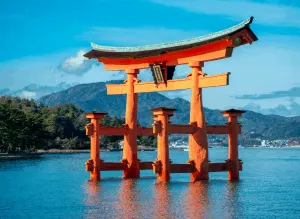
Use this 7 day Japan itinerary to explore some of Japan’s top attractions, like the Itsukushima Shrine pictured here.
Right:
So, per usual, I’m just gonna start by being totally honest here.
And honestly:
There is just no way in HELL that you’ll be able to see all of Japan in 7 days.
Yeah. Sorry, but it’s just not possible.
At least, not without totally burning yourself out or getting approximately NO sleep.
But, that being said:
Thanks to Japan’s nifty railway system/JR pass, there are still LOADS of different places that you can see during a 7 day Japan itinerary.
So:
If you’re down and ready to get started, then let’s start with the bustling city life of Japan’s one and only…Tokyo!
Toyko (3 Nights)
Day 1 – West Tokyo
Usually:
I would recommend spending at least 4 nights in Tokyo, just so that you can really experience everything this city has to offer.
Because:
Remember before when I said that Tokyo was HUGE?
Well, I was NOT lying.
Which is why 4 days in Tokyo is definitely ideal.
But, if you’re short on time:
Then two days is still a decent amount of time to spend in this city and it will help you get a feel for this amazing place.
So:
To start your whirlwind trip through Tokyo, head to the famous Shibuya district.
Because once you’re here:
You’ll be able to cross the street, just outside of Shibuya Station, at one of the busiest intersections in the WORLD!
Sure:
It’s beyond chaotic and crazy, but it’s also definitely all things Tokyo.
Also:
While you’re here, do try and visit some of the insanely quirky shops that can be found in this area.
Next Up?
A trip to the vibrant Harajuku neighborhood, which is brimming over with colorful street art, quirky vintage clothing stores, young people who are wearing only the FUNKIEST of fashions, and fun cosplay shops along Takeshita Street.
And while there are a ton of different things to see and do here:
No trip to Harajuku would be complete without stopping for a giant cotton candy at Totti Candy Factory and visiting the world-famous, Meiji Shrine.
Also:
Don’t forget to do as the locals do and snap some pics in a local ‘Purikura. AKA, a popular Japanese-style photo booth where you can take photos, decorate them as you like, and then print them off on sticker paper.
You should also probably stop by Kawaii Monster Café while you’re here, which is a wonderfully weird, themed cafe that features colorful, themed rooms, casual eats, fun cocktails, and regular, live performances.
Next:
Head back to the Metropolitan Government Building for an amazing FREE view of the city, but not before stopping at Ramen Road for a quick dinner.
Then finally:
Finish your evening off with a trip to Park Hyatt Tokyo, where you can create your very own ‘Lost in Translation’ moment.
Or:
You can always skip the serenity of the park and just straight up, live la vida loca at ’Timeout’ instead; a jazz/blues bar where the music never really stops.
Because once the live music ends, that’s when the karaoke begins…
Day 2 – East Tokyo
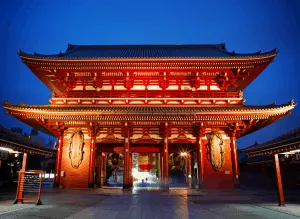
On day two, you’ll see the more traditional side of Tokyo and visit Sensoji Temple, an ancient Buddhist temple in Asakusa.
Okay:
We want ultra-modern yesterday.
So:
Let’s switch things up and go a bit more traditional today.
And the best place to do that?
Why East Tokyo of course! It’s a bit more historic and slightly less chaotic than the other side of the city.
So:
Once you’re here, feel free to explore top, Tokyo attractions like Sensoji Temple (it’s the super famous, ancient Buddhist temple in Asakusa), Tsukiji (there’s even a viewing area here for the popular tuna auction. LOL) and Toyosu Fish Markets and Ueno Park’s Museum District.
Now, once you’ve done ALL OF THAT:
Finish the day off on a more modern note in Akihabara, a Tokyo neighborhood that is known for its plethora of awesome arcade games.
You can also get some rather delicious ramen here, and enjoy some gorgeous, panoramic views from atop Tokyo Sky Tree (and sorry, but the views here are VERY un-free).
Day 3- Tokyo Day Trip To Mount Fuji or DisneySea
Today there are two different options available to you, depending on what you’re into.
You could:
Take a train from Tokyo Station to Hakone, for some beyond STELLAR views of Mount Fiji (The awesomeness of the views largely depends on the weather, so make sure that you visit on a nice, clear day).
Along the way:
You should also visit the exquisite floating torii gate at Hakone shrine, explore the many walking trails here, and indulge your inner Jack Sparrow with a boat ride across the lake.
OR:
You could always go for option two and check out the iconic, DisneySea theme park,
Now:
BEFORE you start violently screaming at me and throwing your laptop across the room in disgust, hear me out.
Because in truth:
DisneySea isn’t just ANY theme park. It’s actually one of the most lavish theme parks in the entire world.
Which is why it’s a super fun, super safe place for solo travelers to go.
And added bonus?
It’s also strangely Japanese, making it at least a mildly cultural experience.
Plus:
Locals adore it. Like, it’s a national treasure level adore it.
So:
A day spent here will not only elevate your inner child to near euphoric states of happiness, but you’ll also get to experience a more modern side of Japanese culture.
Which is a total win-win, at least in my humble opinion.
***For the love of God and all that is HOLY, if you do decide to visit DisneySea, then do yourself a favor and PLEASE BUY YOUR TICKETS IN ADVANCE! LIKE RIGHT NOW! Trust me on this. You do not want to get there, just to spend hours waiting in line for a ticket. This is a very un-fun way to solo travel Japan.***
Kyoto (3 Nights)
Day 4 – Kyoto
Is riding in a bullet train on your Japan bucket list?
If so:
Then prepare to tick that item right off your list. Because you’re about to jump aboard the Shinkansen and travel all the way to Kyoto.
If you can:
Try and catch an early morning train since the trip will take around two hours.
AND REMEMBER:
Be sure to sit on the right side of the train so that you can get that iconic shot of Mount Fiji!
Now:
While you may be tempted to rest after your early morning train ride, let’s be honest here.
You really DON’T have time for that.
So, embrace the mildly exhausted explorer within and get out there!
But:
If you’re not exactly sure where to start, then you can always try a walking tour, which is a great way to quickly and easily experience all that Kyoto has to offer..
However:
If walking tours are SOOO NOT your thing, then you can always visit Nijo Castle and Kyoto Imperial Palace instead, both of which are incredibly impressive attractions(to say the very least).
And if you’re hungry:
Be sure to stop by both Nishiki Market and Pontocho Alley for some of the best food in the city.
Whatever you do though:
Do not leave without devouring an uber-yummy, ‘okonomiyaki’ pancake!
NOM, NOM, NOM.
Day 5 – East Kyoto
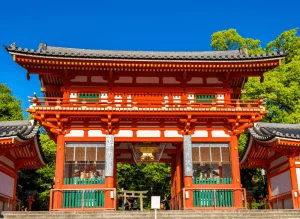
Beautiful Yasaka Shrine in Kyoto, Japan.
Like with Tokyo:
You could easily spend more than 3 days in Kyoto as you solo travel Japan.
However:
With this Japan 7 day itinerary, you’ll easily be able to see most of Kyoto’s top attractions.
So:
Start your day off right, with a visit to some of the city’s most spectacular shrines.
And while Yasaka Shrine and Maruyama Park are ALWAYS beautiful, they are exceptionally stunning during cherry blossom season and autumn, when you have the vibrant, fall foliage in the background.
But:
You can always embrace your inner tourist instead (make sure to have those selfie sticks and fanny packs handy) and follow the popular “temple route” through Kyoto.
This path starts at Kiyomizudera Temple, follows a GIANT, straight-line through the foothills of Kyoto’s Higashiyama Mountains, and takes you to some of the most stunning temples in the area.
And once you’re totally templed out:
Head to Kyoto’s Gion district for some evening Geisha spotting (PSST: Kyoto also has a seriously awesome night walk through picturesque Gion, Kyoto’s geisha district. But the best part? This tour costs only $12 per person! Yup, money well spent as you learn all about kimonos and the unique history of geishas)!
You could even partake in a traditional tea ceremony or have dinner at Sukemasa, which is known for serving some of the BEST gyozas in Japan!
Day 6 – Kyoto West
Next:
It’s time to head west and visit the city’s famous Arashiyama and Sagano districts.
And I know it sounds totally weird:
But, you MUST start your day with a 7-Eleven egg breakfast sandwich.
Because yes:
They really are THAT good!
Once the HANGRY beast within is properly satiated:
Head to the Arashiyama Monkey Forest.
And yes:
You REALLY will want to get here EXTRA early, just to avoid the crowds.
Because this ultra-famous bamboo grove really is a total tourist hotspot.
But, if you’re someone who is prone to crowd phobia:
Then you can always visit Okochi Sanso Villa and Jojakkoji Temple instead, both of which are great off-the-beaten-path attractions.
Although:
If this is your first solo trip to Japan, then you may want to stick with some of the area’s more well-known attractions.
Finally:
End your day at Fushimi Inari Shrine, which features over 4 kilometers of winding walking paths that are filled with quaint AF torii gates.
Again:
This is definitely one of Japan’s most popular attractions (AKA crowded as hell), but so beautiful and totally worth a visit.
If you can:
Try and arrive around dusk so that you can experience the beautiful sunset amidst slightly less enormous hordes of tourists.
Day 7 – Leave Kyoto and Head Home
If you can afford it:
Save yourself some time and fly home from Kansai International Airport in Osaka and not Narita or Haneda in Tokyo.
Trust me:
This airport is infinitely closer to you and will help you maximize your short time in Japan.
But:
If this option isn’t cost-effective, then you can always explore the local food and shopping scene right around Osaka Station, before boarding your train to Tokyo
Remember:
The train ride takes AT LEAST two and a half hours.
And once you do arrive in Tokyo:
You’ll want to give yourself plenty of time since it will take you about an hour to get from the train station to Narita Airport when using the Narita Express (tickets also cost about $36 per person).
Conversely:
If you’re flying out of Haneda Airport, you could always take the Keihin-Tōhoku Line of the subway, towards Kamata, and then transfer to the Airport Monorail at Hamamatsuchō Station.
In total:
It should take you about thirty minutes to get from Tokyo Station to Haneda Airport.
And there you have it!
You have just concluded your awesome, chaotic, whirlwind, once-in-a-lifetime trip to Japan.
BRAVO (insert copious amounts of jazz hands here)!
AND NOW…SOME FINAL THOUGHTS ON SOLO TRAVEL IN JAPAN (JERRY SPRINGER, EAT YOUR HEART OUT!)
Okay:
So while this Japan solo travel guide is basically OVER, there are just a few more things I want to remind you of, before we say a fond farewell.
So:
First rule of Japan solo travel? Always book your hotels WELL IN ADVANCE since accommodations tend to fill up CRAZY QUICKLY!
Therefore:
Do NOT, I repeat, DO NOT wait until the last minute to book all of your hotels.I know you may think that you’ll score some wicked awesome, last-minute hotel deals.
But I promise you won’t. In fact:
Do this and you’ll have a hard time finding ANYWHERE to stay. Like at all. Especially during peak travel seasons.
Okay, now it’s time for some good news!
Because SURPRISE! The power outlets in Japan are EXACTLY the same as the ones in North America.
So:
No need to add any annoying power adapters to your Japan packing list!
HOORAY!
Oh, and if you’re a theme park addict, you’ll definitely want to book your tickets to Disneyland Tokyo and Universal Studios (featuring the Wizarding World of Harry Potter, for all my fellow Potterheads out there!), WELL in advance.
You’ll also want to do a bit of research and look at some crowd calendars on Google, just to figure out what time and day to visit (And since you’re alone, feel free to skip all of those ridiculously long lines and just hop on the single rider line instead).
Alright cool kids:
That’s enough from me! I am so blowing this popsicle stand of solo travel awesome.
Because:
In all seriousness, that really is all she wrote!
So, until next time:
Continue to live the solo travel dream like the TOTAL rockstar that I know you are!
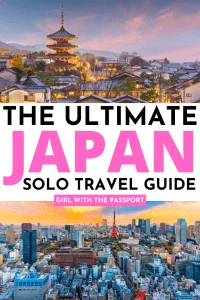
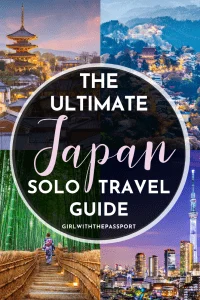

Micamyx|Senyorita
Saturday 11th of January 2020
Solo Travelers who will come across this post are lucky! So comprehensive!
I've been to Japan twice - Tokyo in 2014 to visit my best friend who was based there at that time and Nagoya side in 2015. I plan to go back this year to do a bit of solo backpacking. This is a good guide. Cheers!
Mica
girlwiththepassport
Monday 13th of January 2020
Thanks so much for reading Mica and have an AMAZING trip!
Val
Saturday 11th of January 2020
Just waiting for the Olympics year to end so I can visit Japan! Super handy and detailed post and as always I love your small details! Super curious to try out these black eggs for which I had never heard anything!!
girlwiththepassport
Monday 13th of January 2020
YES! When you get to Hakone give them a try and let me know what you think. Thanks for reading!
Emma
Saturday 11th of January 2020
This was so helpful + informative! I’m planning to visit Japan solo soon so this was amazing to read!
girlwiththepassport
Monday 13th of January 2020
So happy to hear that and thank you so much for reading!